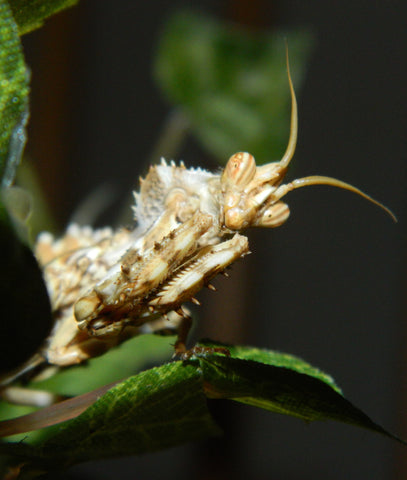Thistle Mantis Caresheet
Housing
The Thistle mantis (Blepharopsis mendica) can grow to be 2 to 3 inches long, without much difference between the sexes. As adults, they should be kept in an enclosure that is at least 12 inches tall, and at least 3 times as wide as the mantis is long. The ideal enclosure would be a mesh or screen cage to ensure optimal ventilation so humidity levels do not stay too high, and should be provided with supplemental heat from an incandescent desk lamp or low power reptile heat lamp. The cage must have a mesh or screen top to allow the mantis to hang upside down during molting, as well as plenty of empty space near the top which is at least 2 times the size of the mantis.
Thistle mantises are a desert species, and require low humidity levels and extra warmth. For these reasons, living vivariums are not a practical option for them. They should be given a simple enclosure with fake plants and natural decorations such as spanish moss and lichen, with which they blend in nicely. We recommend just using a paper towel at the bottom for easy clean-up, which you can change once a week. You could even add a live, potted plant in the cage, but definitely skip the fully planted terrarium setup for these guys.

Temperature & Humidity
Thistles need heat! The ideal temperature for them is 90°F, but they can be safely kept between 85°F and 104°F, and should have at least 30% relative humidity (RH). To take care of their temperature requirements, you should purchase a heat lamp or a reptile heat emitter before purchasing this mantis. Hang it above the enclosure, several inches away from the top of the cage.
The enclosure should be misted at least once a day so they can drink. When kept in mesh or screen cages, we mist their enclosures twice a day. Since this species requires a heat lamp, humidity can drop extremely low very quickly in the enclosure, without misting at least once a day. Low humidity causes mismolts, so keep this in mind. Most mantises do not like getting sprayed directly, so it is best to try and spray around the mantis, but if you get them a little wet by accident, it is usually no big deal. Use spring water, distilled water, or water filtered by reverse osmosis (RO), but don't use plain tap water.
Feeding
The Thistle mantis should be fed flying prey throughout their entire lives. They are not much for chasing after food, but if they are very hungry, they will. They prefer to sit very still and wait for something to come within reach. These mantises can be fed only blue bottle flies throughout their entire adult lives and remain perfectly healthy and happy.
- L1 nymphs: Should be fed D. melanogaster fruit flies.
- L2 and L3 nymphs: Should be fed D. hydei fruit flies.
- L4 and L5 nymphs: Should be fed house flies, or blue bottle flies.
- L6 nymph to adult: Should be fed blue bottle flies.
For additional information about our experience and observations with raising this species, see our Thistle Mantis Blog.
For additional information about the Thistle mantis from outside sources, including breeding and ootheca care, please reference the link below:
Thistle Mantis (Blepharopsis mendica) Caresheet – Keeping Insects
